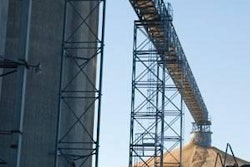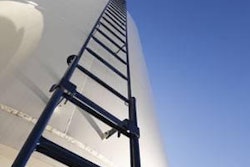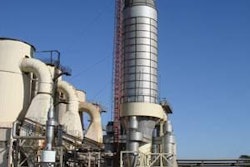When time equals money, the goal is to get the work done in less time without sacrificing safety or quality. This goal applies to delivery of feed with bulk transportation equipment. The fact is that the average bulk feed delivery operation can do the job significantly faster simply by cutting the time it takes to unload trucks during delivery.
Twenty-five years ago, unloading a feed truck or trailer loaded with typical chicken and hog feeds at 2,000-2,500 pounds per minute was ‘high-speed unloading'. But in the 21st Century, at the very least, the standard should be 3,000 lbs, 1.5 tons, per minute.
Today almost every feature on bulk feed delivery equipment is focused on safety, user-friendliness, and ease-of-operation. Feed bodies are available with hand-held remotes that raise and rotate the discharge auger or stinger and turn them on and off. Units also feature rearview camera systems, air-operated compartment gates, and pneumatic handrails. And yet, with all of this advanced technology, many new bulk feed units still are equipped with slow, antiquated discharge systems, which typically are the bottleneck in fast feed delivery.
Design for high-speed, high-quality discharge
When fleet managers hear of feed trucks unloading at rates over 3,000 lbs per minute, they often assume the truck engine must idle extremely high, and that the discharge system's hydraulic pressure must be very high also. Actually, with a well-designed trailer auger discharge system, engine idle remains low and hydraulic pressure is right around 1,600-1,700 psi, pumping 17 gallons per minute, not the typical 20 gallons per minute or more.
Being able to unload over half-a-ton per minute faster than before may not sound like much, but putting some real-life figures to it shows how much time and money a feed truck fleet can save (see table Savings').
When my grandfather, Paul Hensley, founded our family firm back in 1962, he spent a great deal of time designing and engineering mill equipment, including bucket elevators, screw conveyors, and transition augers. He realized that the more transitions that material had to flow through, the greater the chance for product damage. So when he and my father, Gregg Hensley, started manufacturing bulk feed bodies and trailers in the 1980s, they already had the knowledge needed for a simple, practical, and fast unloading auger system with the least amount of transitions possible. By eliminating the cross auger or trough from the bulk body, pelleted feeds remain intact with fewer fines ending up in the farm tank, conveyors, and feeders.
The best design solution for auger-type discharge from the feed body is to use a true 'vertical' auger or a slanted auger with no cross auger. The reason is simple: A gravity-fed auger always transitions material faster and with less damage to the material than a force-fed auger.
True vertical and slanted augers
The problem that some feed truck fleets have with a true vertical auger system is height restrictions. The problem they have with a slanted auger system is the fear of 'free wheeling,' when the operator loses control of the delivery auger boom. Today, however, the hazard of free-wheeling is so uncommon that most feed companies and contract haulers using properly engineered equipment do not consider it a major concern.
The biggest cause of free-wheeling on slanted augers is extreme torque that is put on the turning device and chain. This torque may occur if the operator tries to turn the discharge auger boom before raising it out of the saddle, or if the boom strikes a building or bin. In either case, the extra hydraulic pressure put on both the chain and turning device causes one or both to give way, allowing the boom or stinger to swing freely.
The engineering solution to discharge auger boom free-wheeling is the use of turning device relief valves. These valves take all of the hydraulic pressure off the turning device and chain by simply allowing the hydraulic oil to by-pass. Even under extreme torque conditions, there is no damage to the turning device or chain.
Balancing power and size of augers
Focusing on the bulk body's augers, what is best for safe, high-quality, high-speed feed unloading?
Beginning inside the bulk body, the floor auger should have a high torque motor to ensure that the auger can move more feed to the rear at a higher rate. Next, the discharge system should have a larger diameter vertical auger with proper pitch flighting to remove feed quickly from the floor auger. This is a big factor in faster unloading.
Unfortunately, there is a popular notion that a 9-inch vertical auger can lift all of the feed delivered by a 9-inch floor auger. The notion is wrong. In fact, a 9-inch floor auger can transfer more feed to the vertical auger than even a 12-inch vertical auger can take away. It actually takes longer to push material upward rather than to drag it horizontally. This occurs because gravity is at work in the vertical auger, pulling the feed down. Also, feed in the vertical auger moves outward, over the edge or lip of the screw and falls down the tube.
Also, it is important to recognize differences in 9-12-9' auger unloading systems, where the numerals refer to the sequence of diameters (in inches) of screws in the floor auger, vertical auger, and discharge auger. There are significant performance differences in 9-12-9 auger systems based on the screw-to-tube wall clearance. Most 12-inch vertical augers use a 13-inch auger tube, whereas a more precisely engineered and manufactured vertical auger makes use of a 12.75-inch tube. In this vertical auger, there is less gap between the screw flighting and the tube wall. Minimal clearance inside the tube causes less feed to fall down the side, allowing more material to be transported up and out.
Another design detail is the use of 'cupped' screw flighting, especially in the vertical auger. Cupped flighting speeds up unload rates and reduces product damage. With cupped flighting on the vertical auger, material is pushed toward the center or axis of the auger tube, instead of toward the tube walls as with standard, conventional flighting. Today, a vertical auger with conventional screw flighting often can be replaced with a cupped auger, which can increase discharge rates and reduce product damage during discharge.



.jpg?auto=format%2Ccompress&fit=crop&h=167&q=70&w=250)











